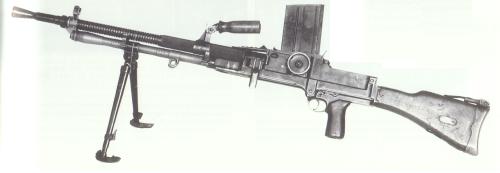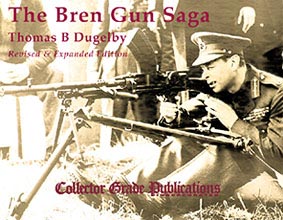 |
Interwar Light
Machinegun Development in Czechoslovakia
History - Praga I - Praga IIA - Praga I-23 - M24 - ZB26 - ZB27 - ZB30 - ZB30J - Bren |
 |
|
|
|
|
Firearms Technical Trivia, December 2000:
 |
Interwar Light
Machinegun Development in Czechoslovakia
History - Praga I - Praga IIA - Praga I-23 - M24 - ZB26 - ZB27 - ZB30 - ZB30J - Bren |
 |
History
World War One had ended. The
Austro-Hungarian Empire was dissolved. In the midst of the chaos
falling out of this situation, the newly created state of Czechoslovakia,
whose existence had been guaranteed by the Treaty of Versailles, went about
the onerous task of creating an army.
Initially, the only weapons available to the new state were those that had managed to survive the war. Many Czechoslovak soldiers and Home Guardsmen bore the Austrian weapons that they had carried home from the battlefields. Meanwhile, the former Austro-Hungarian arsenals situated on Czech territory were filled with captured Russian and Italian munitions. To add to the confusion, the Russians, French and Italians had organized Czech prisoners of war into Legions to fight on the Allied side. These various Czech Legions were armed and equipped by the host countries that had raised them. As a result, the Russian Czech Legion came home from Siberia (after a harrowing part in the Russian Civil War and subsequent anabasis) armed partially with Russian weapons but mostly with Japanese arms, as well as a smattering of French Chauchat light machineguns. So prevalent were the Japanese arms that Sellier & Bellot, renowned Czech ammunition manufacturers, tooled up to produce 6.5mm Arisaka ammunition for the over 40,000 rifles then in use by Czech forces.
The 47,000 men of the Russian Czech Legion were joined by the 45,000 men of the Italian Czech Legion, all armed with Italian weapons, and the 7,000 men of the French Czech Legion, who all carried French weapons. To this amalgamation of weaponry was added the spoils from the Austrian arsenals on Czech soil as well as some 40,000 Mauser Gewehr 98's purchased from the Dutch government. (The Dutch, neutral during the war, had interned the rifles from German troops who had elected to retreat through Holland in November 1918.)
As a result of the variegated sources by which the Czechs came by their arms, by 1921 the Czech Army was equipped with no fewer than 92 types of infantry weapons, most of which were very well used, including M1895 and earlier Mannlicher rifles and carbines, Gewehr 98 Mauser variants, Mosin-Nagant M91 rifles, Arisaka Type 30 and 38 (and older) rifles and carbines, Mannlicher-Carcano Model 1891 rifles, Lebel Model 1886 and Berthier Model 1907/15 rifles and carbines, Austrian Model 1907 and 1912 pistols, Hungarian Frommer pistols, Austrian, French, German, Russian and Spanish revolvers, Austrian M1907, M1907/12, and M1916 Schwarzlose machineguns, Vickers and Lewis machineguns, Hotchkiss M1914 and Chauchat M1915 machineguns, and Maxim MG08 and MG08/15 machineguns. The result was that the Czech logistics system had to come up with at least a dozen different types of ammunition, ranging in caliber from 6.5mm to 9mm, and with countless dimensional variations, such as those between 9mm Parabellum, which uses a case that is 19mm long, and the 9mm Steyr, which uses a 23mm long case.
Not only were the Czechs awash in many different types of arms, but they found themselves at the cusp of a new tactical reality as well. The deployment of large numbers of machineguns caused the traditional use of infantry as massed bodies of riflemen to cease. The basic combat element shrank from the battalion to the company to the platoon to the squad and finally to what the French would call the groupe de combat, which was centered upon the automatic rifleman or light machinegunner, who was then surrounded by a group of riflemen, grenadiers, or storm troopers. The postwar Czech Army subscribed wholly to this theory, and issued the "lightened" M1907/12 Austrian Schwarzlose machinegun to the Infantry on a variety of tripods in lieu of a proper automatic rifle or light machinegun, and the French Chauchat to their Cavalry. Neither of these were very successful, as the Schwarzlose was described as "an unfortunate Austrian heritage which did not prove itself" and the Chauchat "The French fusil mitrailleur has so many defects that its introduction is certainly temporary."
Despite the limitations of the available weaponry, the Czechs evolved the "Combat Cluster," a body of 13 men centered on a light automatic weapon which was described as "the soul of the combat troops." Indeed, as early as 1920, the Czech General Staff was insisting that all infantry squads be equipped with some form of light automatic weapon and that the Armament Department was urged to study all new concepts and ideas as none of the old weapons satisfied the needs of the new tactical concepts. At the same time the Czechs were coming to the realization of the importance of building a national munitions industry. No neighbor could be considered a source of munitions, as they either did not have the production capacity, or during wartime, that supply could be cut off. As a result, the decision to build a domestic production base was "logical and inevitable."
Realizing that what was necessary was a new weapons system built around a light machinegun, the Czech Ministry of Defense sought out the latest designs from around the world. Foreign competitors came to Czechoslovakia as fast as ships and trains would take them. The French brought their new Darne light machinegun in 1920, the Danish Recoil Rifle Syndicate their Madsen in 1922, and in August, 1922, Vickers-Armstrong brought their new Vickers-Berthier. French influence was very strong in the Czech military of the 1920's. So much so, in fact, that the French Military Attaché, General Mittelhauser, was also the Chief of the Czech General Staff. General Mittelhauser was not above using his position to promote French industry. While urging a speedy choice of new light machinegun, General Mittelhauser strongly worked against the idea of domestic production in Czechoslovakia of native designs. Not surprisingly, he judged the Madsen gun to be too expensive to produce and championed the Darne design. After extensive testing of the Darne gun in both 8mm Mannlicher and 7.92mm Mauser, the Ministry of Defense wrote to the Darne company in France and indicated that after testing, they had discovered that the Darne gun "could be ruined in the field in one day."
Early Development

Image Credit: Dugelby, Thomas B, The Bren Gun Saga, Collector Grade Publications, Cobourg, Ontario, 1999 Page 9 |
During the testing of the foreign designs, the nascent Czech arms industry had not been sleeping. In 1920, Vaclav Holek began to work on a light machinegun at the Praga Zbrojovka (Prague Armory) in Vrsovice. Holek's design was based on |
| Further developments of the Praga I by Vaclav Holek led to the Praga IIA. The Praga IIA was also belt fed, but had a modified gas system and was fitted with a modified gas system, a |

Image Credit: Dugelby, Thomas B, The Bren Gun Saga, Collector Grade Publications, Cobourg, Ontario, 1999 Page 10 |

Image Credit: Dugelby, Thomas B, The Bren Gun Saga, Collector Grade Publications, Cobourg, Ontario, 1999 Page 13 |
Vaclav Holek, ever industrious, continued to improve his gun, and the next iteration was christened the Praga I-23. This gun had a removable barrel, a bipod mount, and an adjustable collapsible butt. The design was also belt fed, using |
| The trials were not taking place in a vacuum. Things were becoming tense within the Czech Army's Ordnance Corps. Spares and replacements for the old Schwarzlose |

Image Credit: Dugelby, Thomas B, The Bren Gun Saga, Collector Grade Publications, Cobourg, Ontario, 1999 Page 15 |

Image Credit: Dugelby, Thomas B, The Bren Gun Saga, Collector Grade Publications, Cobourg, Ontario, 1999 Page 22 |
A license agreement was signed between Zbrojovka Brno (ZB) and Praga Zbrojovka in November 1925, which gave the Brno plant the rights to manufacture and sell the M24. The Holek brothers then moved to Brno, and for the first time accurate |
The ZB26's barrel was originally made from Poldi W02 steel from the Poldi steel plant in Kadno, giving a barrel life of some 12,000 rounds. This was later changed to Poldi CKV steel, which raised the barrel life to 14,000 rounds. The receiver and breech were made of Poldi ZTEM chromium nickel steel, giving a life of 250,000 rounds for the receiver and 60,000 rounds for the breech mechanism. Later addition of tungsten to the alloys gave a minimum life of 20,000 rounds for all parts, with the barrel lasting up to 50,000 rounds, and the receiver up to 5,000,000. The first large order for ZB26's came in November 1925 for 4,000 guns, and was completed in 1928. The summer of 1928 saw a second order for 6,600 guns placed. By 1929, the definitive ZB26 had replaced the older types in Czech service and was standard issue in Czech Infantry and Cavalry formations. By 1932 there were some 18,323 ZB26's in service with the Czech Army.
In July, 1936 the Ministry of Defense ordered 10,000 more complete ZB26's, and another 2,600 guns with no mounts for the Directorate of Fortifications. The 1936 order was gradually expanded until it totaled 15,000 ZB26's by 1938. In the spring of 1938 an additional 10,020 ZB26's were ordered, as well as an additional 1,400 guns with no mounts for the Directorate of Fortifications.
By October 1, 1937, Brno had signed contracts with foreign countries which obligated them to deliver some 26,000 ZB26's, ZB30's, ZB30J's, as well as Bren guns for export, with delivery schedules extending into March, 1939. The Ministry of Defense agreed to extend the deadline for delivery of the 1936 order so that exports to China could be accelerated. Exclusive of the export orders, Brno still had to deliver some 22,000 ZB26's to the Czech Army plus another 20,000 for export. Difficulty ensued when the Ministry of Defense finally refused to approve further exports until domestic orders were filled. Brno requested permission to export 15,000 guns held in its own warehouses and all the guns produced in excess of domestic needs in 1939, promising delivery of all outstanding government orders by October 1939. One last government order was placed on October 30, 1938 for 7,025 ZB26's and another 1,000 to be assembled from stockpiled parts. Delivery deadlines were set for late 1939.
The World
Market
The ZB26 and later derivations enjoyed
wide popularity on the world market, and in fact, Brno exported many more
light machineguns that were supplied to the Czech Army. The
ZB26 was first exported to Lithuania and Yugoslavia in 1927 (2,000 guns
each), with the first of many shipments to go to China delivered in 1928.
Between 1929 and 1932, ZB26's in a variety of calibers were exported to
Brazil, Ecuador, Persia and Siam.
| The ZB26 was also the subject of continual development. Improvements in the design of the locking and the unlocking cams on the bolt and piston post resulted in the ZB27. The ZB26 and ZB27 were tested in Romania in 1929, and |

Image Credit: Dugelby, Thomas B, The Bren Gun Saga, Collector Grade Publications, Cobourg, Ontario, 1999 Page 26 |

Image Credit: Dugelby, Thomas B, The Bren Gun Saga, Collector Grade Publications, Cobourg, Ontario, 1999 Page 28 |
As the ZB26/27 was destined for the world market, so events and developments in the world's munitions market had an effect on the continued development of the Czech gun. Toward the end of World War One, |
| Yugoslavia adopted the sS cartridge in 1934. An order for 10,000 ZB26's was placed in 1935, with a delivery scheduled for August 1937, and further possibility of licensed production at the Yugoslav State Arsenal at Kragujevac. Brno was |

Image Credit: Dugelby, Thomas B, The Bren Gun Saga, Collector Grade Publications, Cobourg, Ontario, 1999 Page 37 |
A contract was signed with Romania in 1930 for ZB30's, but no guns were delivered for lack of payment. A license production agreement was eventually entered into, and the ZB30 was produced at the Romanian State Arsenal at Cugir as the ZB30R. There was also a Turkish contract. The Turkish ZB30 differed from the Romanian in that it had a lightweight cavalry barrel and was made from different steels due to very strict Turkish specifications. During the Turkish trials, a Turkish general fired an entire twenty round magazine at a target, which, when inspected, was found to contain only one hole. Representatives of Zbrojovka Brno saved the general great embarrassment when they congratulated him on the superlative shooting skills which had enabled him to place all 20 rounds through the same hole! During the Portuguese trials, the ZB30 fired 10,000 rounds with no stoppages whatsoever, and the average dispersion remained the same after 5,000 rounds. As a result of this demonstration, an order for several thousand guns was placed.
By 1938, 120,000 ZB light machineguns of various models had been made at Brno, with the majority being made for export. Up to the outbreak of World War Two, ZB guns were exported to Afghanistan, Bolivia, Chile, China, Egypt, Ethiopia, Guatemala, Persia, Iraq, Japan, Lithuania, Peru, Romania, Spain, Sweden, Turkey, Uruguay, Venezuela, and Yugoslavia. These were only the major contracts - ZB guns went to many more countries.

Image Credit: Dugelby, Thomas B, The Bren Gun Saga, Collector Grade Publications, Cobourg, Ontario, 1999 Page 112 |
Perhaps the one piece to of the story that is missing is that of the ZGB33 and the ZGB34. These guns were made to compete in the English light machinegun trials, as the English sought to rearm their infantry with a modern light automatic weapon. In 1935, the English selected the ZGB34 as the new light machinegun for the |
Conclusion
From their inauspicious beginnings,
the state of automatic weapons development in Czechoslovakia reached dizzying
heights. In fact, it is not unwarranted to observe that with the
possible exception of the Browning Automatic Rifle, the guns developed
in Czechoslovakia were the most influential and important light automatic
weapons in the world.
Note: Data for this month's trivia page was gathered from:
The Bren Gun Saga, by Thomas B. Dugelby, Collector Grade Publications, 2000
The Bren
Gun Saga is available from Collector Grade Publications. Click
on the image to order.
